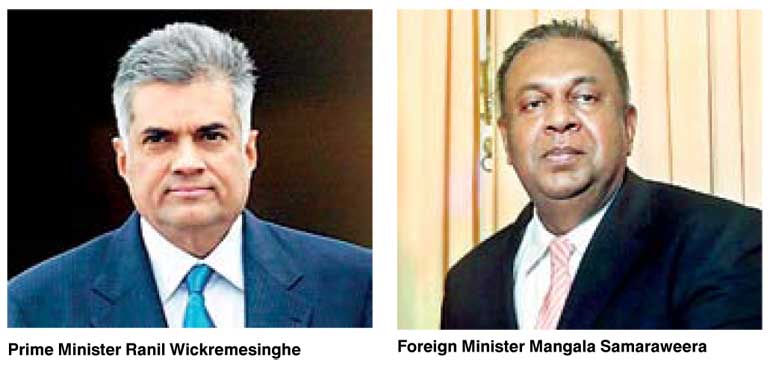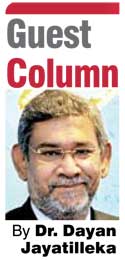Wednesday Sep 10, 2025
Wednesday Sep 10, 2025
Tuesday, 22 September 2015 00:02 - - {{hitsCtrl.values.hits}}
US draft resolution wants demilitarisation of the north and east
By the draft resolutions ye shall know them. While there are sentences introduced into draft resolutions as bargaining chips, a draft resolution is as clear an indication as possible of the real thinking of those who author and sponsor it. This makes it very easy to distinguish between a real friend, ally and partner, an occasional friend and a “frenemy” (friendly foe).
The US draft resolution, or should I say the US-UK draft resolution, attempts to get Sri Lanka to agree to something that the world’s deadliest terrorist militia failed to do in thirty years of war, studded with suicide bombing. It tries to get us to agree to what a 70,000 strong contingent of the world’s fourth largest army did not try to or tried only partially to do. The US resolution, in its Operative Paragraph 15, “Urges the Government of Sri Lanka to…demilitarise the north and east of Sri Lanka…”

(https://www.colombotelegraph.com/index.php/full-text-of-the-hrc-draft-resolution-on-sri-lanka/)
In the very first place it is not the business of the UN Human Rights Council to urge the demilitarisation of any part of any country, and certainly not a country at peace. Troop deployment is a sovereign decision based on the perception of security threats and needs of an independent state.
In the second place, what does “demilitarise” mean? Certainly it does not mean a mere re-profiling of the armed forces presence in the north and east, because if that were the case, there are other terms which could express that idea, such as “drawdown”, “reduction”, “reconfiguration,” etc. No, demilitarisation means just that—and let’s not forget that English is the language of the drafters of the resolution.
Can one imagine an area which saw a 30-year war until a mere six years ago, being demilitarised in any country? The USA took 12 years for the Union (Northern) armies to withdraw from the ex-Confederate South after the Civil War.
Can one imagine the demilitarisation of the sensitive border areas of any country? Can one imagine the demilitarisation of any border area which is separated by a mere 23 km from a landmass inhabited by 70 million ethnics of the populace of that border area?
Can one imagine any country which demilitarises a border province across which there is a landmass whose political leadership i.e. the Chief Minister of Tamil Nadu, has in a formal letter to the Indian PM called in just so many words, for a “Tamil Eelam”?
This is what the US resolution wants us to do—which means this is what the US-UK and the West want us to do. This is what they would like to see as the future of Sri Lanka: an unguarded, insecure, wide-open north and east, devoid of a military presence which deters separatist terrorism or cross border incursion.
This call for demilitarisation has to be seen in tandem with Prime Minister Wickremesinghe’s recent official visit to India, during which a call was paid on him by Indian Union Minister for roadways, Nitin Gadari who briefed him on the $ 5.19 billion ADB funded project to link Sri Lanka and India. You don’t need $ 5.19 billion to build a bridge or a road; you do need it to build a massive underwater tunnel, which has already been announced. Top Indian strategic analyst C. Raja Mohan writing in the Indian express says that the Indian media already calls it the “Hanuman Bridge”.
Thus the big plan is to make Sri Lanka physically part of the Indian subcontinent. It must also be noted that the project will link, not just any part of Sri Lanka with just any part of India but precisely northern Sri Lankan – which the USA draft resolution wants us to demilitarise—with Tamil Nadu—which wants to see a Tamil Eelam in the north and east of Sri Lanka.
The US resolution also calls for the repeal of the Prevention of Terrorism Act as promised by the Sri Lankan Government, which will be substituted by a more suitable piece of legislation.
“13. Affirms the Government of Sri Lanka’s commitment to review and repeal the Prevention of Terrorism Act and replace it with anti-terrorism legislation in line with contemporary international best practices…”
Now if the wording merely called for review and reform it would be unexceptionable, but when it calls for repeal, what it means is that no one currently in jail under the PTA can remain in jail when the Act is repealed. No one can be jailed under a new Act which was not on the books when they were sentenced!
Thus over 200 hard-core terrorists including Black Tigers will be released. Meanwhile the Sri Lankan Government promised in Geneva to repeal the Public Security Ordnance, under which the State declares Emergency and Martial Law. It was not introduced by the  Rajapaksa regime but by a liberal-left post WW II colonial administration in 1947. Imagine the situation in which the north and east have been demilitarised as per the US resolution, ex-Black Tigers are back in those provinces, and the Sri Lankan state has neither the military presence nor the laws as deterrents?
Rajapaksa regime but by a liberal-left post WW II colonial administration in 1947. Imagine the situation in which the north and east have been demilitarised as per the US resolution, ex-Black Tigers are back in those provinces, and the Sri Lankan state has neither the military presence nor the laws as deterrents?
The US draft resolution also calls for the removal from the military and security establishments of anyone who can be ‘credibly implicated’ of having violated human rights. This means those who have not had a fair trial but are “credibly implicated” of having deprived Tiger suicide bombers who might have blown up a bus or train fill of civilians, of their human rights.
“8. Encourages the Government of Sri Lanka to introduce effective security sector reforms as part of its transitional justice process that include ensuring that no scope exists for retention in or recruitment into the security forces of anyone credibly implicated in serious crimes involving human rights violations or abuses or violations of international humanitarian law including members of the security and intelligence units…”
The US Draft resolution tells the Sri Lankan public what our Government has actually promised, namely a special court with a special prosecutor, and goes on to propose that we not only internationalise that mechanism but revise our laws to prosecute those whose only excesses were committed in their zeal to defeat the deadly LTTE and save us, our children and our country from that enemy. The resolution tells us how to punish such people who saved us.
“4. … and calls upon the Government of Sri Lanka, to involve international investigators, prosecutors and judges in Sri Lanka’s justice processes;
5. Encourages the Government of Sri Lanka to review and, where required, reform domestic law to ensure that it allows for prosecution of the full range of crimes under domestic and international law involving violations and abuses of human rights and violations of international humanitarian law.”
16. … calls on the Government of Sri Lanka to review and, as appropriate, repeal or reform legislation and other measures enacted and implemented during the armed conflict and its aftermath so as to reflect the transition to peace and stability on the island and to ensure compliance with Sri Lanka’s international obligations,
17. Calls upon the new Government of Sri Lanka to reform its domestic law to ensure that it can effectively implement its own commitments, the recommendations made in the report of the Lessons Learnt and Reconciliation Commission, as well as the recommendations of the report by the Office of the High Commissioner for Human Rights requested in resolution 25/1, including the investigation and prosecution of those most responsible for the full range of relevant crimes involving violations and abuses of human rights and violations of international humanitarian law”.
The famous line about “international judges, prosecutors and investigators” which the US endorses and has incorporated into the draft resolution could well be a dummy pass, because the well-known journalist Amanda Hodge writing in the leading newspaper The Australian, reported in its 18 September issue, what the game plan really is: “local judges and international investigators”! So they are planning to do a WMD on us, with Western forensic experts crawling all over, digging up doggie bones and alleging mass graves and war crimes.
Meanwhile Foreign Minister Samaraweera and his Prime Minister must stop telling untruths on the public record. Their claim is that President Mahinda Rajapaksa agreed to an accountability mechanism—they sometimes say an international investigation, sometimes a domestic mechanism – in his 23 May 2009 Joint Statement with Ban Ki Moon and later in the May 2009 Resolution in favour of Sri Lanka which obtained a near-two thirds majority in the UN Human Rights Council, on my watch. This is given the lie by the simple fact that the US Draft Resolution refers to and stands upon the Resolutions of 2012, 2013 and 2014, and makes no reference whatsoever to the resolution of 2009 which Sri Lanka won. This is because there was no commitment that the US can refer to which derives from 2009.
The relevant portion of the 23 May 2009 Joint Statement read as follows: “The Secretary General underlined the importance of an accountability process for addressing violations of international humanitarian and human rights law. The Government will take measures to address those grievances.”
As for the Resolution of 27 May 2009, it simply stated in paragraph 10 that the Council “Further welcomes the visit to Sri Lanka of the Secretary-General at the invitation of the President of Sri Lanka, and endorses the joint communiqué issued at the conclusion of the visit and the understandings contained therein”.
The “understandings contained therein” were that the Government would take unspecified measures to address grievances regarding an accountability process with regard to human rights and humanitarian law violations. The “Government will take measures to address those grievances” is hardly a smoking gun; no evidence of any commitment to an accountability mechanism, domestic, international or hybrid. Indeed it is a model of diplomatic ambiguity. The LLRC and the Disappearances Commission, are the measures that the previous Government took, as promised, to address those grievances. That Government’s lapse was in failing to fully implement the LLRC report within a compressed time frame.
The hybrid Sri Lankan Government wants us to believe that we shall be bailed out by our friend the USA and that we must at all times cooperate and collude with it, even when that goes against our core national, strategic and security interests, which as history and geography teach us, are centred on our geo-strategically and demographically vulnerable north-eastern periphery.
The US expects Sri Lanka to agree in the main, to their Geneva draft. If it does so, Sri Lanka is drinking from a poisoned chalice and none of our friends in and outside the Council will be able to save us.
The US Draft resolution circulating in Geneva and the Sri Lankan Government’s complicit posture remind me that Che Guevara used to approvingly quote Frederick Wilhelm of Prussia who said “God save me from my friends; I can take care of my enemies myself”.
(Dr. Dayan Jayatilleka was a Vice President of the UN Human Rights Council, elected to represent the Asian Region in 2007-2008.)